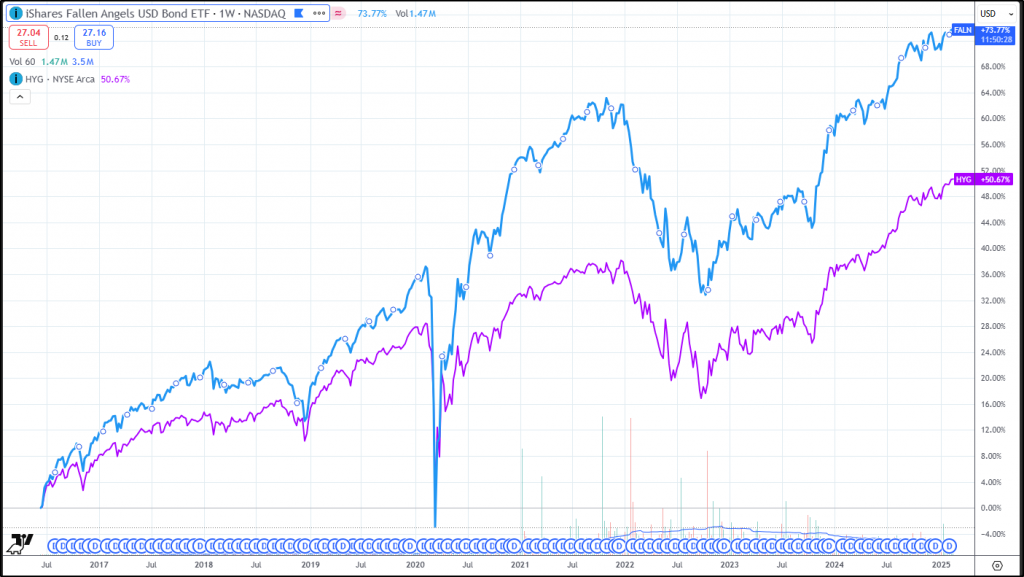What’s a Fallen Angel Bond?
It’s a bond that’s been kicked out of investment-grade paradise.
Once upon a time, it was rubbing shoulders with the blue-chip elite. But then something happened – maybe the company took on too much debt, or the industry hit a rough patch – and next minute, the bond gets downgraded to junk status.
Now, you might think that a bond that’s fallen from grace would be a pariah, shunned by investors. And in some ways, they have… which is precisely why Fallen Angels have a history of outperforming their high-yield peers. More on this below.
Here’s a plot of the returns to FALN (iShares Fallen Angels Bond ETF, blue line) and HYG (iShares High Yield Bond ETF, purple line):

We alerted the RW Pro group to this effect back in early 2023, and have harnessed it ever since.
Recently, a paper about the Fallen Angels effect appeared online that backs up what we’ve been saying.
This research by Diego Alvarez culminates in a long-short strategy that buys Fallen Angels and shorts the high yield index and has an out-of-sample, pre-cost Sharpe of 1.3.
What’s driving this outperformance?
I think it’s primarily driven by mandated selling.
Various institutions (think pension funds, mutual funds, insurance funds) have mandates that require them to sell bonds when they get downgraded. This forced selling pushes these bonds down further than their fair value – even though that fair value is itself lower than it was before the downgrade.
So even though these bonds are worth less than they were before the downgrade, the forced selling pushes them down even further. By providing liquidity into this forced selling, you can buy them at a discount.
And buying something for less than it’s worth is nearly always a good idea.
Is there a trade here?
Now, I know what you’re thinking. This all sounds great, but how do I trade it?
You could go the long-short route, like in the research. Buy Fallen Angels, short, high-yield bonds, and pocket the difference in their performance less costs.
This market neutrality might appeal to hedge funds.
But shorting is expensive for retail traders. So that’s one reason to think twice.
I like to keep things simple, and I don’t mind a bit of extra portfolio variance if it frees up some capital to use elsewhere.
So I harness this effect by maintaining a long position in FALN, the iShares Fallen Angels Bond ETF.

We got interested at the time indicated by that blue arrow (weekly chart). It’s been a handy addition to the portfolio.
If you’re already investing in equity risk premia, why not swap out some of that exposure for Fallen Angels? You’re not adding a ton of new risk but potentially adding an additional return stream.
This is precisely what I did when we first got wind of this effect.
And even if the Fallen Angel effect dissipates over time, you’re still collecting that credit risk premium. As long as you’re not overexposed, it’s a solid addition to a diversified portfolio.
Of course, this isn’t a risk-free trade. These are still junk bonds, and they come with all the usual caveats. But if you size it appropriately and keep your eyes open, I think it’s a simple, compelling trade that’s worth considering.
Would you trade this effect? If so, how? I’d love to hear your take in the comments.


